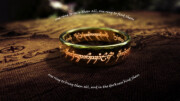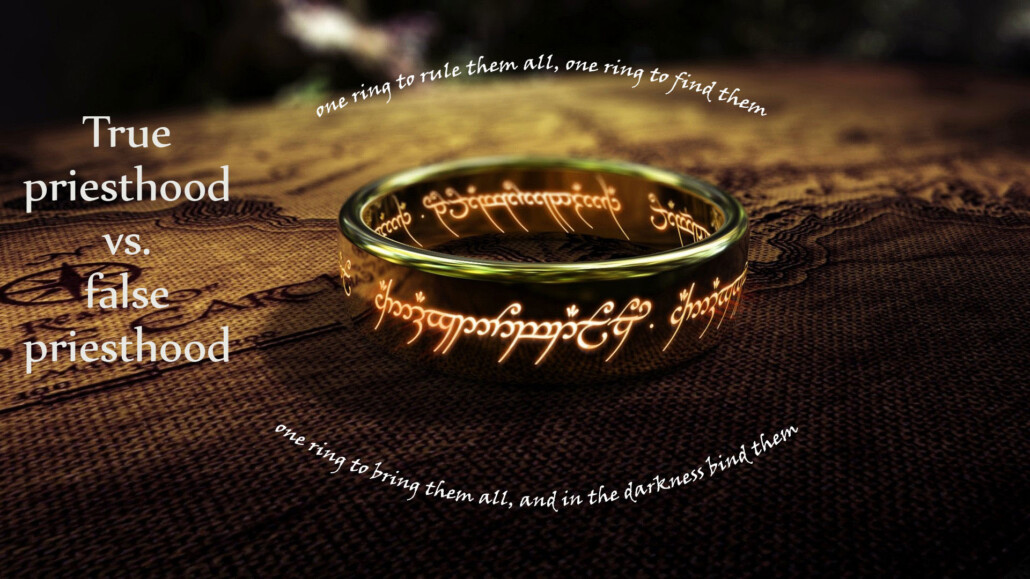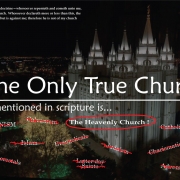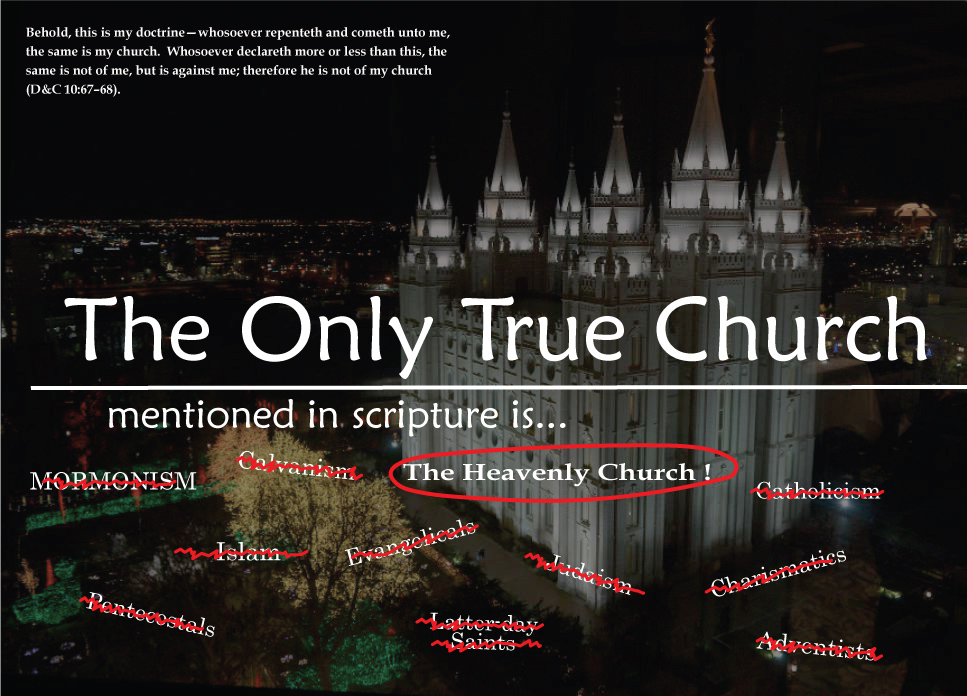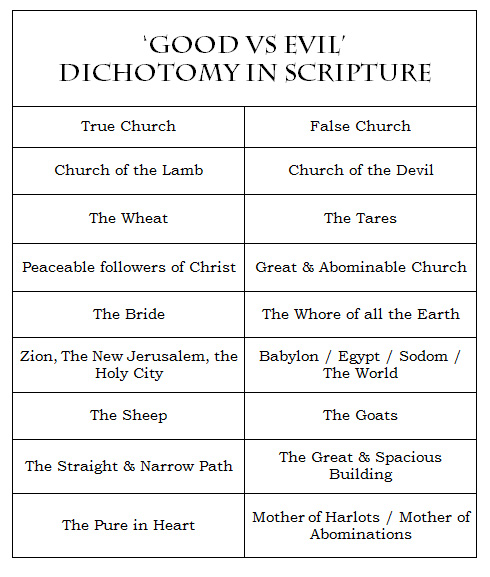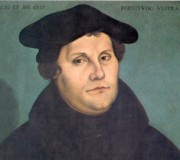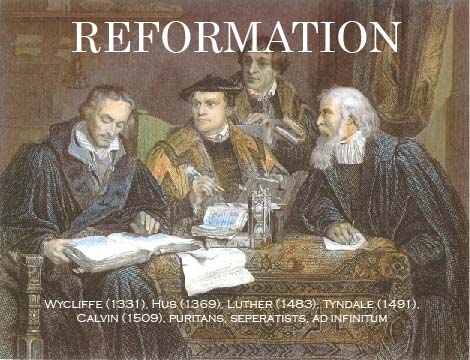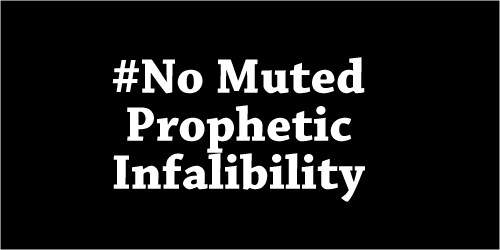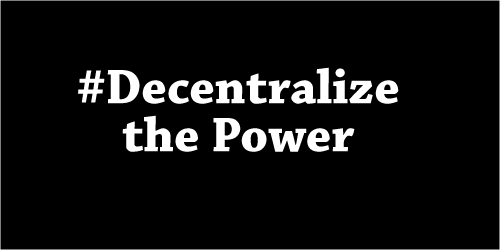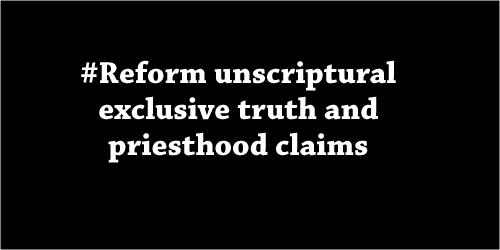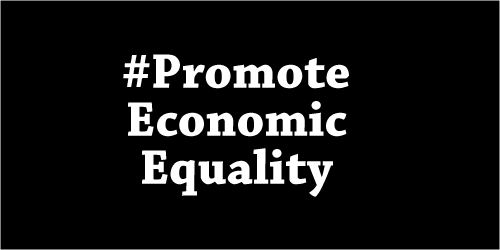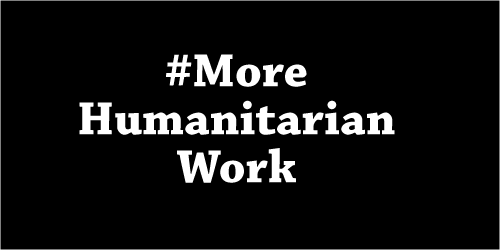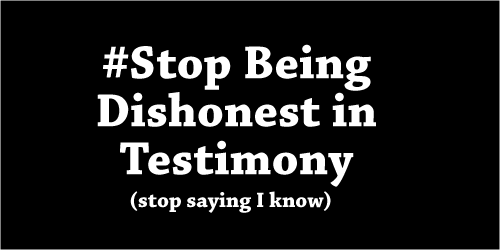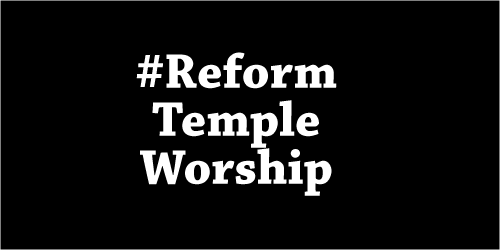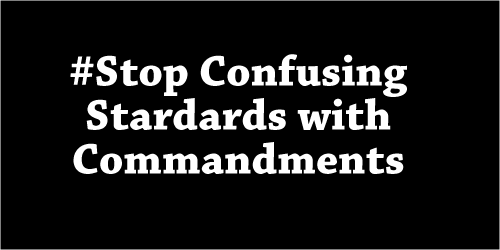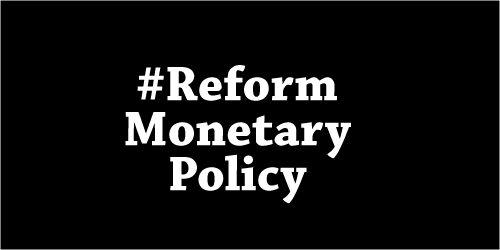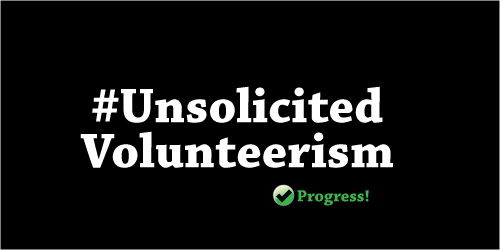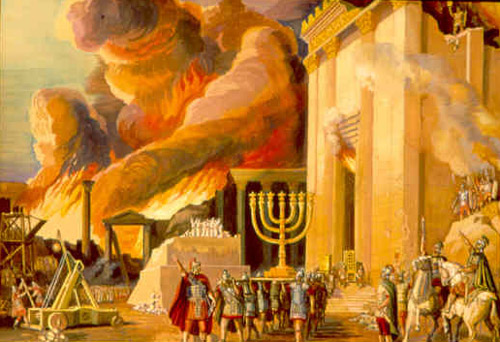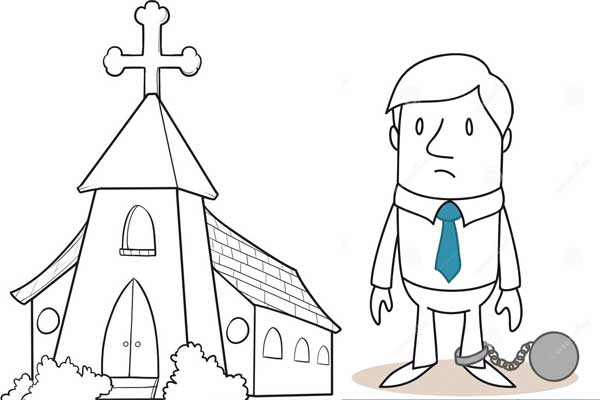The Priesthood of God & Its Relationship to the Only True Church Doctrine
45 “No power or influence can or ought to be maintained by virtue of the priesthood…” (D&C 121:45).
Like many modern books and movies I believe Lord of the Rings teaches an important gospel message. One of its central themes revolves around the idea that power corrupts—so it’s up to the strong and wise to keep it in the hands of the weak and humble until the time that it can be “cast down” by perfect equality and fellowship. I believe this message is very important when it comes to understanding Christian priesthood, and is a theme that runs throughout LDS scripture. In this article I would like to try and show that LDS scripture teaches religious priesthood is not so much a ‘power of God’ but a preparatory symbolic authority given to man by divine beings to test who will stay “humble as a hobbit” like Frodo and Samwise, verses who will be corrupted by its influence like Saruman, Boromir, Theoden, and the race of man.
I love the LDS Church, but I believe that since the days of the earliest Saints there has often been fundamental misunderstandings and misapplications of priesthood in the church which lies at the root of the division this topic has caused—whether it be the use of priesthood authority to to support our exclusive truth claims, or using arguments of priesthood to pressure people into doing things they don’t really feel good about… or even instances of using priesthood arguments to marginalize blacks, women or other groups.
On one hand, misunderstanding and misapplication seems to have has caused people to want a burden and obligation which no person should really desire. On the other hand, privilege and abuse have sometimes caused a thing designed to maintain equality — to promote exclusivity, elitism, inequality and division. Misunderstood principles like “the one true church” and “only true priesthood” doctrines have often turned an equality promoting symbolic responsibility into an inequality promoting honor & privilege. But assuming there is legitimacy in Christian or LDS priesthood, I believe scripture suggests it is part of a test given to religious leaders to find out who might be worthy of true authority in our next rounds of progression.
Sauron, Satan, and the Corrupting Influence of Power
In the book/movie The Lord of the Rings, J.R. Tolkien walks us through a story which illustrates the corrupting influence of power. The story begins with the forging of the Great Rings of power. Nineteen of these rings are given to the leaders of earth to give them “the strength and will to govern each race”. But Tolkien teaches that in accepting these rings the leaders…
“were all of them deceived, for another ring was made. In the land of Mordor, in the fires of Mount Doom, the Dark Lord Sauron forged, in secret, a Master Ring to control all others. And into this Ring he poured his cruelty, his malice and his will to dominate all life. One Ring to rule them all.”
With this master ring, Sauron begins to enslave the people of earth bringing about an apocalyptic war for freedom. In the quest to destroy this “Ring of Power”, Frodo and the fellowship are tested and tried as they battle not only the evil followers of Sauron, but the evil that the ring creates in the hearts of the heroes by its very essence. Gandalf summarizes Tolkien’s view of power with his words concerning the ring,
“I dare not take it. Not even to keep it safe. Understand Frodo, I would use this Ring from a desire to do good. But through me, it would wield a power too great and terrible to imagine.”
To Mormon’s & Christians this plot and what it teaches about power and authority might sound eerily familiar to the Biblical concept of Satan’s fall and plan for worldly dominion. In LDS and even general Christian theology it was the lust for power which caused the archetypal Satan to become a “the fallen archangel”—warring against all that is good. In Joseph Smith’s book of Moses (ch.4), it is explained that in the beginning Satan wanted the honor of redeeming mankind. As opposed to Christ’s plan of self sacrifice and equality— Satan’s plan was to use God’s power to “destroy the agency of man”, redeeming “all mankind, that one soul shall not be lost”. We can only assume from the context given in Moses 4:1–4, as well as subsequent biblical history that his plan was one of using “God’s” honor & authority to create a global totalitarian autocracy to coercively exalt all mankind (but especially himself and his crony power structure).
After his totalitarian plan is rejected, Satan rebels and comes to earth to carry out his plan anyway. Without the true secret to God’s political power or authority (which was self-sacrifice) he comes to earth and creates a false priesthood, which like Sauron’s rings of power, he uses to subtly manipulate, “deceive, blind and lead [people] captive to his will” (Moses 4:4). Satan’s goal seems to have been to either manipulate or trick people into obedience to his autocratic system through false pretenses (Moses 1:19–22), or as a last resort to do what the ancient Jews and many Christians still hope of their false Messiah. To come in power and glory dyed in blood, ready to force every knee to bow to his own egocentric concept of truth, order and righteousness (Rev 13, Dan 7). Just as Tolkien’s book details the corruption of earthly authority into what could be considered Sauron’s ‘false priesthood’, the Bible is–cover to cover–a story of the continual corruption of Jewish and earthly priesthoods into ‘Satan’s false priesthood’ of idolotry and autocratic domination.
In this article I hope to show that by upholding the only true church and only legitimate priesthood doctrines, Mormonism has unwittingly gone contrary to the democratic agency-promoting principles given in many of our own scriptures—and sometimes used the same manipulative tactics of Satan’s false priesthood to uphold autocratic power and authority. Something that we must eradicate if we are to play our key part in Christ’s true spiritual church.
The Difference Between Priesthood and The Powers of Heaven or Spiritual Gifts
Before going into other aspects of the priesthood I believe it’s important to cover what LDS scripture says the priesthood is, and is not. There are many traditional LDS beliefs and teachings which have contributed to the general pride that’s developed around priesthood in LDS culture. Some of this stems from the nearly ubiquitous misunderstanding that priesthood is the supernatural power of God [1a] used to create the world or do miraculous or supernatural acts, or that the priesthood is needed in order to be a prophet (one with the gift of prophecy), exercise divine power or be a religious icon like those idolized in Christian scripture. So why wouldn’t everyone lust after it, right?! If like a magical ring, it gives the power to to heal or to prophesy or to cast out devils or move mountains or split seas or be a leader, prophet, seer or revelator of course it would become a source of pride to those lucky enough to have it, and a source of envy to groups forbidden from it!
A careful examination of the scripture show that priesthood is neither needed nor said to uniquely give people power to do ANY of these things. The scriptures instead teach that Judeo Christian priesthood was simply a symbolic religious order, authority and responsibility which obligates the powerful aspects of society to be a metaphor of the heavenly church, and use one’s attained power for good, and to establish the level of equality needed for group exaltation– and a system to convict it’s holders when they twist it into something opposite its intent. The scriptures make it clear that all the supernatural powers of God are given equally to ALL WORTHY MANKIND (humankind) as “gifts of the Spirit” and are available “by faith” to all people regardless of gender, religion, color or priesthood ordination (see D&C 45, Moroni 7, and 2 Cor 12, 2 Ne 26:33, Lectures on Faith #1).
To confuse the priesthood (which is accessed only by ordination into a specific religious order) WITH the ‘powers of heaven’ or ‘power of God’ or gifts of the Spirit which scripture says are accessed by faith is like confusing the force of George Lucas’ star wars with the order of the Jedi who are trained to use it or Tolkien’s wizards/Istari order with the power or magic they have learned to access. After all, Christian scripture teaches that even Satan and his followers have learned by faith to use the miraculous divine powers, and his power is obviously not the same as the priesthood or order of God. Although mixing these definitions may seem a trivial debate in semantics — by perpetuating these unscriptural misunderstandings we inadvertently cause many to covet or feel excluded from a burdensome obligation of sacrifice that no one should desire.
There is simply NO scriptural support for the ubiquitous traditional LDS doctrine that the “priesthood” is the supernatural power God used to create the world and universe. There is no scriptural support suggesting priesthood has exclusive claim to any of God’s miraculous powers, except an authority or burden of responsibility to religious administration (servitude), to officiate in symbolic ecclesiastical ordinances and seal and symbolically bring a people into God’s presence. D&C 121:45 makes it clear that “That the rights of the priesthood are inseparably connected with the powers of heaven”, but the priesthood should not be confused for the “powers of heaven” or the “power of God” which D&C 88 teaches is “is in all things, which giveth life to all things, which is the law by which all things are governed”.
There are literally hundreds of verses of scripture proving these points, but I trust the average LDS reader can be convinced by reading just a handful. (see footnote [a] for more scriptural examples comparing priesthood with the power of God accessed through faith. see also The Difference Between Priesthood and Prophets , and Ether 12, Heb 11, TG; faith, D&C 88:7–13, 84:45-46, Moses 1:32, Jacob 4:9, Morm 9:17, D&C 29:30–31).
The priesthood is primarily a metaphor or symbol of a heavenly or spiritual system
Technically, priesthood does not even give people a right to authority or rule, per se. Much like Israel and the Christian Church in general, the scriptures teach that the priesthood was created to be an order of servitude and symbol or type of a heavenly spiritual system. A light to show the world how heaven operates. The true priesthood is not like Sauron’s ring, or some imaginary crown which mystically gives individuals God’s authority to rule over others — or to be God’s only revelatory mouthpieces or political regents. [1] Even Tolkien understood that such a system could only come from, and lead to evil. Joseph Smith, perhaps ironically, echoed this sentiment that religious priesthood was never meant to give men true power or authority over others. He wrote in revelation,
“No power or influence can or ought to be maintained by virtue of the priesthood, only [but] by persuasion, long suffering, meekness… [and other Christlike attributes]” (D&C 121:45)
This was fairly clear in the Jewish religious system, as the priesthood was held only by Levites, and authorized its holders ONLY to work as priests in the temple. Prophets, Rabbis and many other Jewish political and religious leaders had no need for the priesthood. It was clearly only a responsibility to administer the symbolic outward ordinances of the religious system. With the advent of Christianity, the Church or congregation became the temple, and the symbolic managerial duties of the temple priests moved to ordained men of the congregation (1 Cor 3:16; Eph 2:21; 1 Peter 2:5) . With the new covenant, instead of sacrificing animals and performing ordinances on behalf of the people, the priesthood was now to follow Christ’s example of sacrificing themselves and performing symbolic ordinances on behalf of the congregation and world (Romans 12:1–2; 15:16; Philip 2:17; 4:18; Heb 13:15–16). So even though early church records show a clear hierarchical administrative system [2] which was associated with priesthood, Christ’s teachings were clear that the Church was not to follow the world’s model of using that priesthood position to support and maintain the organizational hierarchy. (In fact there are many apocryphal sources which suggest Christ created a secret organization of women equal in importance to the men)
The system of heaven which Jesus came to teach was that power and authority came not from position but from self-sacrifice. Knowledge and self sacrifice were to be the “keys” or authority of the kingdom (Matt 16:13–20, D&C 84:19; 107:15). Ordination to an office was never meant to prove one’s legitimacy or give one person authoritative control over another. He taught that only by humbly serving others can we righteously create a hierarchy or gain privilege over the will of another. That no ordinance can truly give authority, the ordinance and priesthood office is a symbol pointing to the type of wise character and level of service which earns true power and authority over others while completely preserving agency. Take the words of Christ to his apostles in Matthew 20 for instance.
25 But Jesus called [his disciples] to him and said, “You know that the rulers of the Gentiles lord it over them, and their great ones exercise authority over them. 26 It shall not be so among you. But whoever would be great among you must be your servant, 27 and whoever would be first among you must be your slave 28 even as the Son of Man came not to be served but to serve, and to give his life… (Matt 20:20–28 ESV) [2b]
The narrative of Christ giving Peter the “keys” of the kingdom hit this point home. (A narrative strangely absent from every gospel but Matthew’s.) Instead of Christ ordaining Peter with a magical power that he could use to rule the church and do miracles to prove Christ’s legitimacy, he promises Peter the “keys of the kingdom of heaven” after a lesson on faith and a “charge” not to flaunt the Messiah title to legitimize their teachings. It then states that Christ began then to teach in depth about self sacrifice before the religious elite,
21 From that time forth began Jesus to shew unto his disciples, how that he must go unto Jerusalem, and suffer many things of the elders and chief priests and scribes, and be killed, and be raised again the third day… 24 Then said Jesus unto his disciples, If any man will come after me, let him deny himself, and take up his cross, and follow me. 25 For whosoever will save his life shall lose it: and whosoever will lose his life for my sake shall find it. (Matt 16:21,24–25)
The entire system of Jewish temple worship & sacrifice, culminating with Jesus coming to be judged and executed by the Jewish priesthood & Roman authorities can be seen as a clear symbolic teaching and example to show both the right way (by humble non-institutionalized example) and the wrong way (by means of religious or political authority) to lead man. The second and third temptations of Christ were an offer by Satan to get power and authority the wrong way. The Christian priesthood was not meant to give man the right or legitimacy to rule over others. It was instituted to give mankind a symbol of a heavenly system—and to teach mankind that true authority over others comes only through self-sacrifice. Heavenly authority is meant to maintain equality through the self-sacrifice and subservience of the leadership. To humble powerful people into being equal slaves and servants in Christ. This is why this responsibility of servitude is often only given to the most assertive and domineering (masculine) aspects of humanity and withheld from the humble or subjugated (feminine) aspects of humanity. That’s not to say women should not have priesthood authority, but instead that priesthood authority was an order and charge of humility given to the powerful, that they should abase themselves to be equals with the less powerful aspects of society. (see footnote[2c])
In fact other revealed texts such as Oahspe 32/ch. 30 (God judges dominions) teach the scripturally supported idea that the cost of human leadership is that no leader can ascend to the higher realms of existence, until he has exalted or risen up all those who had become physically or mentally subjected to them! (see Matt 23:12) That is, that the responsibility and burden of both righteous ecclesiastical leaders or wicked despots was that they could not gain an exalted resurrection until they helped every one of their willing subjects ascend with or ahead of them! In Christ’s words, the first will be made last and the last will be made first. (Matt 19:30; 20:1-16, D&C 29:30)
… I show man not only the way of liberty, but the way of bondage. He shall know understandingly the ways of my dominions, and the judgment that is upon him. 32/30.20. And the same rules shall apply to every king, queen, emperor, and every other ruler in the world. 32/30.21. The resurrection in heaven of each and every one of them shall be with, and no faster than, those they ruled over on earth. 32/30.22. And they shall be responsible to all their subjects[2d]…
LDS teachings commonly use arguments of priesthood to legitimize LDS authority as the only true church, and our General Authorities as Christ’s only true living prophets and apostles on earth. Our entire cultural system of giving General Authorities and priesthood holders the “chief seats in the synagogues” or always insisting “to be called of men Rabbi, Rabbi” [President or Bishop in our case] is directly contrary to Christ’s teachings (see Matt 23:6–12; Luke 23:6, 11:43). Like the Pharisees of Jesus time, I believe we have slowly come to focus too much on priesthood as an eternal authority and honor to be desired instead of merely a responsibility to be shouldered. It has become a way to legitimize dominion and exert one’s own will upon others, instead of being a responsibility of public service which maintains equality. We forget that God respects self determination above all, and will never force compliance contrary to the voice and conscience of the majority. We too often seek to ‘talk up’ the priesthood when we should instead be focusing on the fact that earthly priesthood is a symbolic responsibility and burden that gives assertive individuals an obligation to service — and that service is the true source of heaven’s power (A power open to ALL worthy humankind.) Paul tries repeatedly in his New Testament letters to show the Jews that the Old Testament system and priesthood were types, symbols or schoolmasters pointing to heavenly systems and spiritual truths—not to be confused with the real thing.
10 The law is only a shadow of the good things that are coming–not the realities themselves. For this reason it can never, by the same sacrifices repeated endlessly year after year, make perfect those who draw near to worship. (Hebr 10:1 NIV)
5 They serve at a sanctuary that is a copy and shadow of what is in heaven. This is why Moses was warned when he was about to build the tabernacle: “See to it that you make everything according to the pattern shown you on the mountain.” (Hebr 8:5 NIV)
23 That is why the Tabernacle and everything in it, which were copies of things in heaven, had to be purified by the blood of animals. But the real things in heaven had to be purified with far better sacrifices than the blood of animals.
24 For Christ did not enter into a holy place made with human hands, which was only a copy of the true one in heaven. He entered into heaven itself to appear now before God on our behalf. (Hebr 9:23-24 NLT)
6 He has made us competent as ministers of a new covenant–not of the letter but of the Spirit; for the letter [type/symbol] kills, but the Spirit [meaning behind the symbol] gives life. (2 Cor 3:6 NIV, compare NLT)
Latter day LDS scripture echoes the same sentiment,
16 Now these ordinances were given after this manner, that thereby the people might look forward on the Son of God, it being a type of his order, or it being his order… (Alma 13:16)
13 …that all things may have their likeness, and that they may accord one with another—that which is earthly conforming to that which is heavenly… (D&C 128:13)
According to the LDS worldview, the ancient Jews looked “beyond the mark”, and twisted their religious system into an organization satanic enough to excommunicate and execute their own heavenly King (Jacob 4:14, 2 Ne 10:3). We also hold that the Catholics have their own record of priesthood abuse stemming from their belief that their priesthood is what makes them elected or chosen of God. Certainly, when a religion or mankind misunderstands temporal symbols given by heaven and creates an organization that manipulates people into a exclusivist leadership hierarchy fostering feelings of pride, subservience and inequality the true priesthood is corrupted. Just as declaring one’s self “the only true church” makes a religion run the risk of being part of the church of the devil, using any arguments of priesthood to justify our authority over others runs the risk of losing the true spiritual priesthood (D&C 121:37). Paradoxically, if Mormonism wants to be part of the True Church of God, it must never boast of being the only true church. If it wants to be worthy of the true priesthood, it must hide the tokens of that priesthood by never using priesthood as a reason for its authority or legitimacy. (For example: repeated talks on being the only true church or priesthood, talking up church apostles or leadership, or excommunicating those who challenge authority or repeated talks on “obedience to priesthood”, talks suggesting leaders, the “prophet” or General Authorities are unequal or superior to regular members, or manipulatively teaching that their priesthood “mantle of authority” deserves special respect and thus shouldn’t be questioned or challenged (ie. talks on not “steadying the ark”), instead of letting obedience, respect and submission to authority be a natural outgrowth of people wanting to follow their leaders because of the leadership’s humility, service and sacrifice).
The Two branches of Mormon Priesthood and what they symbolize
I believe LDS scriptures teach that the two branches of Mormon/Biblical ecclesiastical priesthood are a type or metaphor of two larger types of priesthood used by Higher Beings in the management of our world— The Aaronic or temporal priesthood and the Melchizedek or spiritual priesthood. In a way, I believe LDS scriptural teachings on these priesthoods are meant to reconcile the Catholic views on ministerial priesthood with the Protestant views of universal priesthood. The Mormon Aaronic or lower priesthood being a type or symbol pointing to the “temporal” priesthood or earthly authority of the earth’s religions & political organizations. The Mormon Melchizedek, higher or “spiritual” priesthood being a symbol of the “invisible” spiritual or universal priesthood which is used by heavenly/spiritual beings to rule ALL earthy political and religious affairs according to their agency. The earthly temporal lower priesthood like the temporal church, is supposed to copy that higher perfect heavenly system. Its primary purpose is to be a type, symbol or example and schoolmaster to the world.

